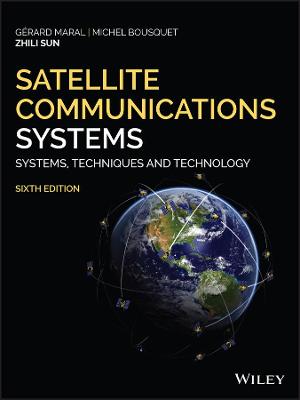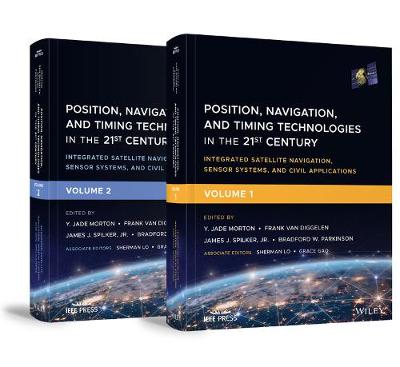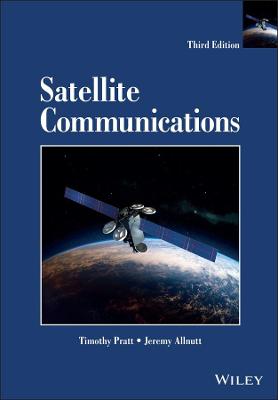Satellite Communications Systems
 -15%
portes grátis
-15%
portes grátis
Satellite Communications Systems
Systems, Techniques and Technology
Bousquet, Michel; Sun, Zhili; Maral, Gerard
John Wiley & Sons Inc
02/2020
800
Dura
Inglês
9781119382089
15 a 20 dias
1582
Descrição não disponível.
Acknowledgement xv
Acronyms xvii
Notations xxiii
1 Introduction 1
1.1 Birth of Satellite Communications 1
1.2 Development of Satellite Communications 1
1.3 Configuration of a Satellite Communications System 3
1.4 Types of Orbit 11
1.5 Radio Regulations 16
1.6 Technology Trends 21
1.7 Services 23
1.8 The Way Forward 25
2 Orbits and Related Issues 29
2.1 Keplerian Orbits 29
2.2 Useful Orbits for Satellite Communication 53
2.3 Perturbations of Orbits 80
2.4 Conclusion 110
3 Baseband Digital Signals, Packet Networks, and Quality of Service (QOS) 113
3.1 Baseband Signals 114
3.2 Performance Objectives 123
3.3 Availability Objectives 124
3.4 Delay 126
3.5 IP Packet Transfer QOS and Network Performance 128
3.6 Conclusion 133
4 Digital Communications Techniques 135
4.1 Baseband Formatting 137
4.2 Digital Modulation 138
4.3 Channel Coding 153
4.4 Channel Coding and the Power-Bandwidth Trade-Off 157
4.5 Coded Modulation 162
4.6 End-To-End Error Control 169
4.7 Digital Video Broadcasting via Satellite (DVB-S) 170
4.8 Second Generation DVB-S (DVB-S2) 175
4.9 New Features of DVB-S2X 183
4.10 Conclusion 184
5 Uplink, Downlink, and Overall Link Performance; Intersatellite Links 189
5.1 Configuration of a Link 190
5.2 Antenna Parameters 190
5.3 Radiated Power 196
5.4 Received Signal Power 197
5.5 Noise Power Spectral Density at the Receiver Input 203
5.6 INDIVIDUAL LINK PERFORMANCE 213
5.7 Influence of the Atmosphere 219
5.8 Mitigation of Atmospheric Impairments 238
5.9 Overall Link Performance with Transparent Satellite 241
5.10 Overall Link Performance with Regenerative Satellite 252
5.11 Link Performance with Multibeam Antenna Coverage vs. Monobeam Coverage 257
5.12 Intersatellite Link Performance 265
6 Multiple Access 275
6.1 Layered Data Transmission 275
6.2 Traffic Parameters 276
6.3 TRAFFIC ROUTING 280
6.4 ACCESS TECHNIQUES 281
6.5 FREQUENCY DIVISION MULTIPLE ACCESS (FDMA) 284
6.6 TIME DIVISION MULTIPLE ACCESS (TDMA) 290
6.7 CODE DIVISION MULTIPLE ACCESS (CDMA) 303
6.8 FIXED AND ON-DEMAND ASSIGNMENT 314
6.9 RANDOM ACCESS 317
6.10 CONCLUSION 322
7 Satellite Networks 325
7.1 Network Reference Models and Protocols 325
7.2 Reference Architecture for Satellite Networks 329
7.3 Basic Characteristics of Satellite Networks 330
7.4 Satellite On-Board Connectivity 334
7.5 Connectivity Through Intersatellite Links (ISLs) 347
7.6 Satellite Broadcast Networks 353
7.7 Broadband Satellite Networks 356
7.8 Transmission Control Protocol 387
7.9 IPV6 OVER SATELLITE NETWORKS 393
7.10 CONCLUSION 396
8 Earth Stations 401
8.1 Station Organisation 401
8.2 Radio-Frequency Characteristics 402
8.3 The Antenna Subsystem 415
8.4 The Radio-Frequency Subsystem 450
8.5 Communication Subsystems 459
8.6 The Network Interface Subsystem 466
8.7 Monitoring and Control; Auxiliary Equipment 474
8.8 Conclusion 476
9 The Communication Payload 479
9.1 Mission and Characteristics of the Payload 479
9.2 Transparent Repeater 482
9.3 Regenerative Repeater 509
9.4 Multibeam Antenna Payload 511
9.5 Introduction to Flexible Payloads 520
9.6 Solid State Equipment Technology 522
9.7 Antenna Coverage 523
9.8 Antenna Characteristics 543
9.9 Conclusion 569
10 The Platform 573
10.1 Subsystems 575
10.2 Attitude Control 576
10.3 The Propulsion Subsystem 595
10.4 The Electric Power Supply 610
10.5 Telemetry, Tracking, and Command (TTC) and On-Board Data Handling (OBDH) 629
10.6 Thermal Control and Structure 648
10.7 Developments and Trends 655
11 Satellite Installation and Launch Vehicles 659
11.1 Installation in Orbit 659
11.2 Launch Vehicles 685
12 The Space Environment 721
12.1 Vacuum 721
12.2 The Mechanical Environment 722
12.3 Radiation 726
12.4 Flux of High-Energy Particles 730
12.5 The Environment During Installation 734
13 Reliability and Availability of Satellite Communications Systems 737
13.1 Introduction to Reliability 737
13.2 Satellite System Availability 741
13.3 Subsystem Reliability 743
13.4 Component Reliability 749
References 754
Index 755
Acronyms xvii
Notations xxiii
1 Introduction 1
1.1 Birth of Satellite Communications 1
1.2 Development of Satellite Communications 1
1.3 Configuration of a Satellite Communications System 3
1.4 Types of Orbit 11
1.5 Radio Regulations 16
1.6 Technology Trends 21
1.7 Services 23
1.8 The Way Forward 25
2 Orbits and Related Issues 29
2.1 Keplerian Orbits 29
2.2 Useful Orbits for Satellite Communication 53
2.3 Perturbations of Orbits 80
2.4 Conclusion 110
3 Baseband Digital Signals, Packet Networks, and Quality of Service (QOS) 113
3.1 Baseband Signals 114
3.2 Performance Objectives 123
3.3 Availability Objectives 124
3.4 Delay 126
3.5 IP Packet Transfer QOS and Network Performance 128
3.6 Conclusion 133
4 Digital Communications Techniques 135
4.1 Baseband Formatting 137
4.2 Digital Modulation 138
4.3 Channel Coding 153
4.4 Channel Coding and the Power-Bandwidth Trade-Off 157
4.5 Coded Modulation 162
4.6 End-To-End Error Control 169
4.7 Digital Video Broadcasting via Satellite (DVB-S) 170
4.8 Second Generation DVB-S (DVB-S2) 175
4.9 New Features of DVB-S2X 183
4.10 Conclusion 184
5 Uplink, Downlink, and Overall Link Performance; Intersatellite Links 189
5.1 Configuration of a Link 190
5.2 Antenna Parameters 190
5.3 Radiated Power 196
5.4 Received Signal Power 197
5.5 Noise Power Spectral Density at the Receiver Input 203
5.6 INDIVIDUAL LINK PERFORMANCE 213
5.7 Influence of the Atmosphere 219
5.8 Mitigation of Atmospheric Impairments 238
5.9 Overall Link Performance with Transparent Satellite 241
5.10 Overall Link Performance with Regenerative Satellite 252
5.11 Link Performance with Multibeam Antenna Coverage vs. Monobeam Coverage 257
5.12 Intersatellite Link Performance 265
6 Multiple Access 275
6.1 Layered Data Transmission 275
6.2 Traffic Parameters 276
6.3 TRAFFIC ROUTING 280
6.4 ACCESS TECHNIQUES 281
6.5 FREQUENCY DIVISION MULTIPLE ACCESS (FDMA) 284
6.6 TIME DIVISION MULTIPLE ACCESS (TDMA) 290
6.7 CODE DIVISION MULTIPLE ACCESS (CDMA) 303
6.8 FIXED AND ON-DEMAND ASSIGNMENT 314
6.9 RANDOM ACCESS 317
6.10 CONCLUSION 322
7 Satellite Networks 325
7.1 Network Reference Models and Protocols 325
7.2 Reference Architecture for Satellite Networks 329
7.3 Basic Characteristics of Satellite Networks 330
7.4 Satellite On-Board Connectivity 334
7.5 Connectivity Through Intersatellite Links (ISLs) 347
7.6 Satellite Broadcast Networks 353
7.7 Broadband Satellite Networks 356
7.8 Transmission Control Protocol 387
7.9 IPV6 OVER SATELLITE NETWORKS 393
7.10 CONCLUSION 396
8 Earth Stations 401
8.1 Station Organisation 401
8.2 Radio-Frequency Characteristics 402
8.3 The Antenna Subsystem 415
8.4 The Radio-Frequency Subsystem 450
8.5 Communication Subsystems 459
8.6 The Network Interface Subsystem 466
8.7 Monitoring and Control; Auxiliary Equipment 474
8.8 Conclusion 476
9 The Communication Payload 479
9.1 Mission and Characteristics of the Payload 479
9.2 Transparent Repeater 482
9.3 Regenerative Repeater 509
9.4 Multibeam Antenna Payload 511
9.5 Introduction to Flexible Payloads 520
9.6 Solid State Equipment Technology 522
9.7 Antenna Coverage 523
9.8 Antenna Characteristics 543
9.9 Conclusion 569
10 The Platform 573
10.1 Subsystems 575
10.2 Attitude Control 576
10.3 The Propulsion Subsystem 595
10.4 The Electric Power Supply 610
10.5 Telemetry, Tracking, and Command (TTC) and On-Board Data Handling (OBDH) 629
10.6 Thermal Control and Structure 648
10.7 Developments and Trends 655
11 Satellite Installation and Launch Vehicles 659
11.1 Installation in Orbit 659
11.2 Launch Vehicles 685
12 The Space Environment 721
12.1 Vacuum 721
12.2 The Mechanical Environment 722
12.3 Radiation 726
12.4 Flux of High-Energy Particles 730
12.5 The Environment During Installation 734
13 Reliability and Availability of Satellite Communications Systems 737
13.1 Introduction to Reliability 737
13.2 Satellite System Availability 741
13.3 Subsystem Reliability 743
13.4 Component Reliability 749
References 754
Index 755
Este título pertence ao(s) assunto(s) indicados(s). Para ver outros títulos clique no assunto desejado.
Guide to satellite communications systems; techniques and technology; satellite network architecture; satellite communication applications; state of the art satellite communications; international standards from ITU-R, ITU-T, ETSI, CCSDS and IETF; algorithms of satellite communications; GEO satellites; MEO/LEO constellation satellites; DVB-S/S2/S2X; DVB-RCS/RCS2/RCS2X; IP over satellites; inter satellite links
Acknowledgement xv
Acronyms xvii
Notations xxiii
1 Introduction 1
1.1 Birth of Satellite Communications 1
1.2 Development of Satellite Communications 1
1.3 Configuration of a Satellite Communications System 3
1.4 Types of Orbit 11
1.5 Radio Regulations 16
1.6 Technology Trends 21
1.7 Services 23
1.8 The Way Forward 25
2 Orbits and Related Issues 29
2.1 Keplerian Orbits 29
2.2 Useful Orbits for Satellite Communication 53
2.3 Perturbations of Orbits 80
2.4 Conclusion 110
3 Baseband Digital Signals, Packet Networks, and Quality of Service (QOS) 113
3.1 Baseband Signals 114
3.2 Performance Objectives 123
3.3 Availability Objectives 124
3.4 Delay 126
3.5 IP Packet Transfer QOS and Network Performance 128
3.6 Conclusion 133
4 Digital Communications Techniques 135
4.1 Baseband Formatting 137
4.2 Digital Modulation 138
4.3 Channel Coding 153
4.4 Channel Coding and the Power-Bandwidth Trade-Off 157
4.5 Coded Modulation 162
4.6 End-To-End Error Control 169
4.7 Digital Video Broadcasting via Satellite (DVB-S) 170
4.8 Second Generation DVB-S (DVB-S2) 175
4.9 New Features of DVB-S2X 183
4.10 Conclusion 184
5 Uplink, Downlink, and Overall Link Performance; Intersatellite Links 189
5.1 Configuration of a Link 190
5.2 Antenna Parameters 190
5.3 Radiated Power 196
5.4 Received Signal Power 197
5.5 Noise Power Spectral Density at the Receiver Input 203
5.6 INDIVIDUAL LINK PERFORMANCE 213
5.7 Influence of the Atmosphere 219
5.8 Mitigation of Atmospheric Impairments 238
5.9 Overall Link Performance with Transparent Satellite 241
5.10 Overall Link Performance with Regenerative Satellite 252
5.11 Link Performance with Multibeam Antenna Coverage vs. Monobeam Coverage 257
5.12 Intersatellite Link Performance 265
6 Multiple Access 275
6.1 Layered Data Transmission 275
6.2 Traffic Parameters 276
6.3 TRAFFIC ROUTING 280
6.4 ACCESS TECHNIQUES 281
6.5 FREQUENCY DIVISION MULTIPLE ACCESS (FDMA) 284
6.6 TIME DIVISION MULTIPLE ACCESS (TDMA) 290
6.7 CODE DIVISION MULTIPLE ACCESS (CDMA) 303
6.8 FIXED AND ON-DEMAND ASSIGNMENT 314
6.9 RANDOM ACCESS 317
6.10 CONCLUSION 322
7 Satellite Networks 325
7.1 Network Reference Models and Protocols 325
7.2 Reference Architecture for Satellite Networks 329
7.3 Basic Characteristics of Satellite Networks 330
7.4 Satellite On-Board Connectivity 334
7.5 Connectivity Through Intersatellite Links (ISLs) 347
7.6 Satellite Broadcast Networks 353
7.7 Broadband Satellite Networks 356
7.8 Transmission Control Protocol 387
7.9 IPV6 OVER SATELLITE NETWORKS 393
7.10 CONCLUSION 396
8 Earth Stations 401
8.1 Station Organisation 401
8.2 Radio-Frequency Characteristics 402
8.3 The Antenna Subsystem 415
8.4 The Radio-Frequency Subsystem 450
8.5 Communication Subsystems 459
8.6 The Network Interface Subsystem 466
8.7 Monitoring and Control; Auxiliary Equipment 474
8.8 Conclusion 476
9 The Communication Payload 479
9.1 Mission and Characteristics of the Payload 479
9.2 Transparent Repeater 482
9.3 Regenerative Repeater 509
9.4 Multibeam Antenna Payload 511
9.5 Introduction to Flexible Payloads 520
9.6 Solid State Equipment Technology 522
9.7 Antenna Coverage 523
9.8 Antenna Characteristics 543
9.9 Conclusion 569
10 The Platform 573
10.1 Subsystems 575
10.2 Attitude Control 576
10.3 The Propulsion Subsystem 595
10.4 The Electric Power Supply 610
10.5 Telemetry, Tracking, and Command (TTC) and On-Board Data Handling (OBDH) 629
10.6 Thermal Control and Structure 648
10.7 Developments and Trends 655
11 Satellite Installation and Launch Vehicles 659
11.1 Installation in Orbit 659
11.2 Launch Vehicles 685
12 The Space Environment 721
12.1 Vacuum 721
12.2 The Mechanical Environment 722
12.3 Radiation 726
12.4 Flux of High-Energy Particles 730
12.5 The Environment During Installation 734
13 Reliability and Availability of Satellite Communications Systems 737
13.1 Introduction to Reliability 737
13.2 Satellite System Availability 741
13.3 Subsystem Reliability 743
13.4 Component Reliability 749
References 754
Index 755
Acronyms xvii
Notations xxiii
1 Introduction 1
1.1 Birth of Satellite Communications 1
1.2 Development of Satellite Communications 1
1.3 Configuration of a Satellite Communications System 3
1.4 Types of Orbit 11
1.5 Radio Regulations 16
1.6 Technology Trends 21
1.7 Services 23
1.8 The Way Forward 25
2 Orbits and Related Issues 29
2.1 Keplerian Orbits 29
2.2 Useful Orbits for Satellite Communication 53
2.3 Perturbations of Orbits 80
2.4 Conclusion 110
3 Baseband Digital Signals, Packet Networks, and Quality of Service (QOS) 113
3.1 Baseband Signals 114
3.2 Performance Objectives 123
3.3 Availability Objectives 124
3.4 Delay 126
3.5 IP Packet Transfer QOS and Network Performance 128
3.6 Conclusion 133
4 Digital Communications Techniques 135
4.1 Baseband Formatting 137
4.2 Digital Modulation 138
4.3 Channel Coding 153
4.4 Channel Coding and the Power-Bandwidth Trade-Off 157
4.5 Coded Modulation 162
4.6 End-To-End Error Control 169
4.7 Digital Video Broadcasting via Satellite (DVB-S) 170
4.8 Second Generation DVB-S (DVB-S2) 175
4.9 New Features of DVB-S2X 183
4.10 Conclusion 184
5 Uplink, Downlink, and Overall Link Performance; Intersatellite Links 189
5.1 Configuration of a Link 190
5.2 Antenna Parameters 190
5.3 Radiated Power 196
5.4 Received Signal Power 197
5.5 Noise Power Spectral Density at the Receiver Input 203
5.6 INDIVIDUAL LINK PERFORMANCE 213
5.7 Influence of the Atmosphere 219
5.8 Mitigation of Atmospheric Impairments 238
5.9 Overall Link Performance with Transparent Satellite 241
5.10 Overall Link Performance with Regenerative Satellite 252
5.11 Link Performance with Multibeam Antenna Coverage vs. Monobeam Coverage 257
5.12 Intersatellite Link Performance 265
6 Multiple Access 275
6.1 Layered Data Transmission 275
6.2 Traffic Parameters 276
6.3 TRAFFIC ROUTING 280
6.4 ACCESS TECHNIQUES 281
6.5 FREQUENCY DIVISION MULTIPLE ACCESS (FDMA) 284
6.6 TIME DIVISION MULTIPLE ACCESS (TDMA) 290
6.7 CODE DIVISION MULTIPLE ACCESS (CDMA) 303
6.8 FIXED AND ON-DEMAND ASSIGNMENT 314
6.9 RANDOM ACCESS 317
6.10 CONCLUSION 322
7 Satellite Networks 325
7.1 Network Reference Models and Protocols 325
7.2 Reference Architecture for Satellite Networks 329
7.3 Basic Characteristics of Satellite Networks 330
7.4 Satellite On-Board Connectivity 334
7.5 Connectivity Through Intersatellite Links (ISLs) 347
7.6 Satellite Broadcast Networks 353
7.7 Broadband Satellite Networks 356
7.8 Transmission Control Protocol 387
7.9 IPV6 OVER SATELLITE NETWORKS 393
7.10 CONCLUSION 396
8 Earth Stations 401
8.1 Station Organisation 401
8.2 Radio-Frequency Characteristics 402
8.3 The Antenna Subsystem 415
8.4 The Radio-Frequency Subsystem 450
8.5 Communication Subsystems 459
8.6 The Network Interface Subsystem 466
8.7 Monitoring and Control; Auxiliary Equipment 474
8.8 Conclusion 476
9 The Communication Payload 479
9.1 Mission and Characteristics of the Payload 479
9.2 Transparent Repeater 482
9.3 Regenerative Repeater 509
9.4 Multibeam Antenna Payload 511
9.5 Introduction to Flexible Payloads 520
9.6 Solid State Equipment Technology 522
9.7 Antenna Coverage 523
9.8 Antenna Characteristics 543
9.9 Conclusion 569
10 The Platform 573
10.1 Subsystems 575
10.2 Attitude Control 576
10.3 The Propulsion Subsystem 595
10.4 The Electric Power Supply 610
10.5 Telemetry, Tracking, and Command (TTC) and On-Board Data Handling (OBDH) 629
10.6 Thermal Control and Structure 648
10.7 Developments and Trends 655
11 Satellite Installation and Launch Vehicles 659
11.1 Installation in Orbit 659
11.2 Launch Vehicles 685
12 The Space Environment 721
12.1 Vacuum 721
12.2 The Mechanical Environment 722
12.3 Radiation 726
12.4 Flux of High-Energy Particles 730
12.5 The Environment During Installation 734
13 Reliability and Availability of Satellite Communications Systems 737
13.1 Introduction to Reliability 737
13.2 Satellite System Availability 741
13.3 Subsystem Reliability 743
13.4 Component Reliability 749
References 754
Index 755
Este título pertence ao(s) assunto(s) indicados(s). Para ver outros títulos clique no assunto desejado.
Guide to satellite communications systems; techniques and technology; satellite network architecture; satellite communication applications; state of the art satellite communications; international standards from ITU-R, ITU-T, ETSI, CCSDS and IETF; algorithms of satellite communications; GEO satellites; MEO/LEO constellation satellites; DVB-S/S2/S2X; DVB-RCS/RCS2/RCS2X; IP over satellites; inter satellite links





